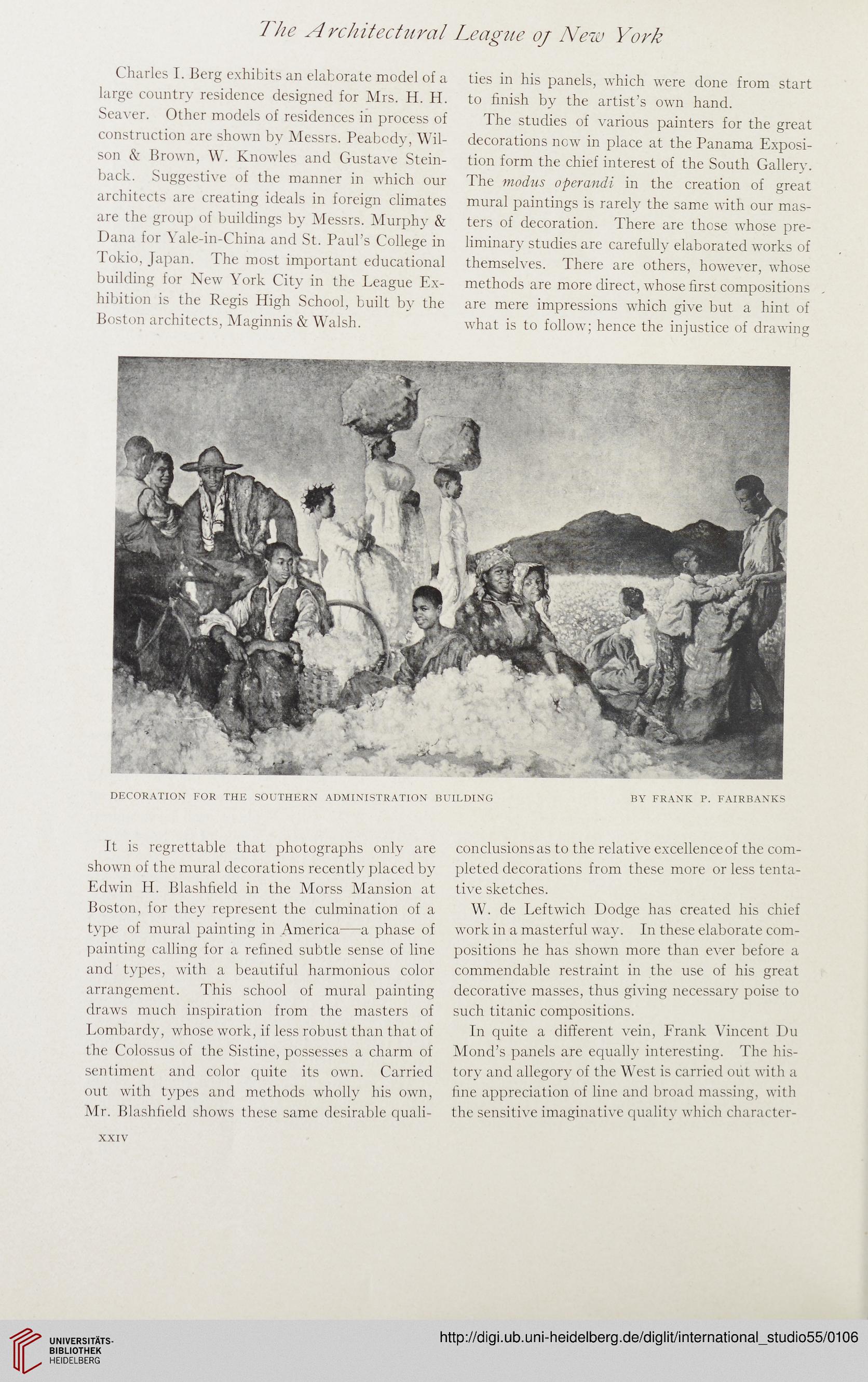The Architectural League oj New York
Charles I. Berg exhibits an elaborate model of a
large country residence designed for Mrs. H. H.
Seaver. Other models of residences in process of
construction are shown by Messrs. Peabody, Wil-
son & Brown, W. Knowles and Gustave Stein-
back. Suggestive of the manner in which our
architects are creating ideals in foreign climates
are the group of buildings by Messrs. Murphy &
Dana for Yale-in-China and St. Paul’s College in
Tokio, Japan. The most important educational
building for New York City in the League Ex-
hibition is the Regis High School, built by the
Boston architects, Maginnis & Walsh.
ties in his panels, which were done from start
to finish by the artist’s own hand.
The studies of various painters for the great
decorations new in place at the Panama Exposi-
tion form the chief interest of the South Gallery.
The modus operandi in the creation of great
mural paintings is rarely the same with our mas-
ters of decoration. There are those whose pre-
liminary studies are carefully elaborated works of
themselves. There are others, however, whose
methods are more direct, whose first compositions
are mere impressions which give but a hint of
what is to follow; hence the injustice of drawing
DECORATION FOR THE SOUTHERN ADMINISTRATION BUILDING BY FRANK P. FAIRBANKS
It is regrettable that photographs only are
shown of the mural decorations recently placed by
Edwin H. Blashfield in the Morss Mansion at
Boston, for they represent the culmination of a
type of mural painting in America—a phase of
painting calling for a refined subtle sense of line
and types, with a beautiful harmonious color
arrangement. This school of mural painting
draws much inspiration from the masters of
Lombardy, whose work, if less robust than that of
the Colossus of the Sistine, possesses a charm of
sentiment and color quite its own. Carried
out with types and methods wholly his own,
Mr. Blashfield shows these same desirable quali-
conelusions as to the relative excellence of the com-
pleted decorations from these more or less tenta-
tive sketches.
W. de Leftwich Dodge has created his chief
work in a masterful way. In these elaborate com-
positions he has shown more than ever before a
commendable restraint in the use of his great
decorative masses, thus giving necessary poise to
such titanic compositions.
In quite a different vein, Frank Vincent Du
Mond’s panels are equally interesting. The his-
tory and allegory of the West is carried out with a
fine appreciation of line and broad massing, with
the sensitive imaginative quality which character-
XXIV
Charles I. Berg exhibits an elaborate model of a
large country residence designed for Mrs. H. H.
Seaver. Other models of residences in process of
construction are shown by Messrs. Peabody, Wil-
son & Brown, W. Knowles and Gustave Stein-
back. Suggestive of the manner in which our
architects are creating ideals in foreign climates
are the group of buildings by Messrs. Murphy &
Dana for Yale-in-China and St. Paul’s College in
Tokio, Japan. The most important educational
building for New York City in the League Ex-
hibition is the Regis High School, built by the
Boston architects, Maginnis & Walsh.
ties in his panels, which were done from start
to finish by the artist’s own hand.
The studies of various painters for the great
decorations new in place at the Panama Exposi-
tion form the chief interest of the South Gallery.
The modus operandi in the creation of great
mural paintings is rarely the same with our mas-
ters of decoration. There are those whose pre-
liminary studies are carefully elaborated works of
themselves. There are others, however, whose
methods are more direct, whose first compositions
are mere impressions which give but a hint of
what is to follow; hence the injustice of drawing
DECORATION FOR THE SOUTHERN ADMINISTRATION BUILDING BY FRANK P. FAIRBANKS
It is regrettable that photographs only are
shown of the mural decorations recently placed by
Edwin H. Blashfield in the Morss Mansion at
Boston, for they represent the culmination of a
type of mural painting in America—a phase of
painting calling for a refined subtle sense of line
and types, with a beautiful harmonious color
arrangement. This school of mural painting
draws much inspiration from the masters of
Lombardy, whose work, if less robust than that of
the Colossus of the Sistine, possesses a charm of
sentiment and color quite its own. Carried
out with types and methods wholly his own,
Mr. Blashfield shows these same desirable quali-
conelusions as to the relative excellence of the com-
pleted decorations from these more or less tenta-
tive sketches.
W. de Leftwich Dodge has created his chief
work in a masterful way. In these elaborate com-
positions he has shown more than ever before a
commendable restraint in the use of his great
decorative masses, thus giving necessary poise to
such titanic compositions.
In quite a different vein, Frank Vincent Du
Mond’s panels are equally interesting. The his-
tory and allegory of the West is carried out with a
fine appreciation of line and broad massing, with
the sensitive imaginative quality which character-
XXIV




